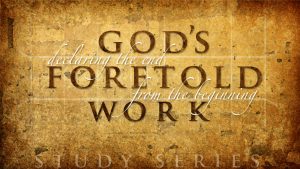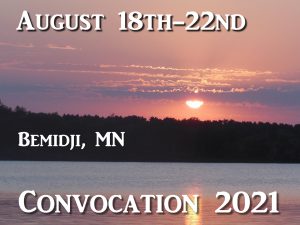I am in an ongoing dialogue concerning the near-far fulfillment of OT prophecy at the moment. Especially concerning text’s like Isaiah 19, considering the current situation in Egypt. How is it best to simply & clearly show that many OT testament text’s may have been spoken a few thousand years ago, even with like-kind-near-fulfillments, but with ultimate outworking at the end?
Good question, Nick. I’d have to think about that, and review some of the texts that would be best to demonstrate the near / far phenomena, so intrinsic to the OT mystery of Christ and the gospel. In every context where the eschatological day of the Lord is in view, there is usually a near and a far fulfillment. This is seen most clearly by the simple fact that the messianic salvation, everywhere identified with a climactic post tribulational day of the Lord, simply did not happen. A view of the inerrancy of the inspired scripture, will, of course, demand that a gap be recognized between the past, near and partial fulfillment, and a future fulfillment that is complete and exhaustive.
Even if you happen to deny a distinct future for natural Israel, and even if you are prone to interpret scripture allegorically, one is still obliged to recognize that the promised messianic salvation did not come until much later with the advent of Jesus. Beyond the earnest and first fruits (the “already”) of Israel’s promised salvation, there remains the “not yet” of a yet future day of the Lord that will accomplish “the restoration of all things spoken by the prophets” (Acts 3:21; Ro 11:25-29).
[Note: The difference between pre-mill and a-mill eschatology is simply the question of how much of Israel’s promised salvation came in with the revelation of the gospel? All or part? […] (The “complete” note is available as a footnote (([Note: The difference between pre-mill and a-mill eschatology is simply the question of how much of Israel’s promised salvation came in with the revelation of the gospel? All or part? If all, then nothing more remains for the “natural branches.” In such case, there’s no need of a “literal” millennium (i.e., as a distinct period of time on this earth beyond the present age.)
If nothing remains for “natural Israel,” the only choice is to spiritualize all the language of scripture that describes conditions on earth AFTER the post-tribulational day of the Lord (This process of “re-interpretation” amounts to nothing short of a bold vaporization of large portions of scripture. Such a process is particularly suspect when these sections of prophecy show an abundance of detailed description that defies easy reduction to mere symbol or poetic metaphor.
To handle prophetic speech in this way suggests something more condemnable than mere questions of hermeneutics. It permits prior theological commitments to impose on scripture what it does not say, while it denies much that scripture does say. Regardless of original intent, the end result is unbelief concerning what God has infallibly ‘said’. A faulty hermeneutic risks adding support to the question first raised by Satan, “Has God really said?” It is that serious. We are not simply engaged in academic discussion of marginal significance.)
For the prophets, no end was in sight that did not include the final deliverance of the Jewish nation and the resurrection of the righteous at the end of an unequaled tribulation of brief duration (Dan 12:1-2 with Jer 30:7; Mt 24:21). Only an “all righteous” nation (Isa 60:21; Jer 31:34), dwelling securely forever in their own land, would be sufficient to fulfill and publicly vindicate the everlasting covenant, as it stood written. This, of course, requires a post-day of the Lord fulfillment on this earth.
For the covenant to realize all its promised goals according to the plain language and manifest intent of the prophets, a millennium on earth becomes a theological necessity, even before its chronological duration is later given by John. If, on the other hand, “all” the promises made to natural Israel receive their complete fulfillment in this present age (as taught by a-mill eschatology), then WHY have a millennium at all? Why not go straight to the new heavens and earth, as in a-mill eschatology? If a future great tribulation can come and go without the covenanted salvation of the present enemies of the gospel, then a literal millennium would seem rather superfluous, if all the promises to Israel are fulfilled within the scope of the present age.])) or as a separate sub-article HERE)]
But back to your question: Despite how much scorn has been heaped on those who recognize a gap between the 69th and 70th weeks of Dan 9:24-27, it remains that anyone accepting the authority of the NT, must acknowledge a gap in a number places throughout the OT, where this phenomenon appears. It would be a worthwhile exercise to find and list every instance where this blending of the near and the far occurs.
Israel’s eschatology of the ever imminent day of the Lord, is typically portrayed against the backdrop of the threatening menace of the contemporary super power (Assyria, Babylon, Medes, etc.). Daniel is unique in separating the contemporary near fulfillment from the more distant and ultimate fulfillment by his vision of the seventy sevens.
At the end of the seventieth seven (the last half of the last seven, to be precise; Dan 7:25; 9:27; 12:7, 11), all the historical types of the final desolator find their ultimate anti-type in the “little horn” of Daniel’s prophecy (Ezek 38:17; Dan 7:8; 8:9, 23; 11:21, 36-37 with 2Thes 2:4). His reign of terror will complete the cycle of Israel’s covenant chastisement, ending in the messianic redemption. Of course, the NT would reveal the mystery of Christ’s twofold advent that would make glorious sense of what lay hidden to the puzzling foreview of the prophets, (1Pet 1:11-12). The mystery would add to, but not change the fundamental eschatology of the OT.
In fact, where better to note the distinction between the near and far fulfillment than Daniel’s vision of the progress of human government? Unless one is prepared to spiritualize the resurrection, a gap of centuries MUST be recognized between Greece (Dan 8, 11) and Rome (Dan 2, 7, 9), and the full eschatological end that follows the last and greatest tribulation (Dan 11:35-36; 12:1-2 with Mt 24:21; 2Thes 2:4, 8).
The doings of Antiochus IV Epiphanes was at best an only partial and typical fulfillment of the coming Antichrist, who meets his end, not in a failed attack on Susa in 164 B.C., but by the breath of the Lord (Isa 11:4; 30:31, 33; 31:8; Dan 8:25; 11:45; 2Thes 2:8), at Christ’s return and the resurrection of the righteous (Dan 11:35-37; 12:1-2; Mt 24:21; 2Thes 2:3-4, 8). Thus, all conservative schools of prophetic interpretation must recognize some kind of extended interim (gap) between the near and the far in a number of places. The only question is precisely where.
For me, OT descriptions of Israel’s ultimate redemption, is proof positive that the advance visitation of the powers of that coming day in an Assyrian, Babylonian, or Grecian invasion, does not cancel or ‘re-interpret’ a more ultimate fulfillment “immediately after the tribulation of those days” (Jer 30:7; Dan 12:1; Mt 24:21). An earnest of Israel’s ultimate eschatological future becomes present and actual whenever the powers of that coming day break into history, whether for weal or woe. However, this pattern of fulfillment should not be taken to imply change or ‘re-interpretation” of the plain language of prophecy, and the definite timing of the post-tribulational day of the Lord. The events of the end must yet answer to the highly descript language of the prophecies down to the last jot and tittle.
Remember, the key will always be to show the basic order of Israel’s eschatology, which is no less the eschatology of the NT, with this one difference: The day of the Lord restoration of Israel is now understood in terms of Christ’s return (Acts 3:21). Though the mystery is magnificent in what it adds, it changes nothing of the plain language of promise.
That basic outline of events is as follows: The age ends with a definite and specific period of unequaled tribulation that is of a very definite but short duration. Study how to make this clear and undeniable. This coming tribulation is marked by many definite signs that distinguish it from tribulation in general (Dan 11:23-31; 12:11; Mt 24:15; 2Thes 2:3-5 etc), and unless one is willing to spiritualize, not only Christ’s post-tribulational return (Mt 24:29-31), but also the resurrection, you can show beyond reasonable dispute that the unequaled tribulation of Jer 30:7, Dan 12:1, and Mt 24:21 ends with nothing short of the resurrection of the righteous dead (Dan 12:1-2, 13; Isa 25:8; 26:19).
Once the unequaled tribulation of “the end” (Dan 8:17, 19; 9:27; 11:27, 35, 40; 12:4, 6, 8-9, 13), is seen and acknowledged, it becomes very difficult, even dishonest, to deny to chastened Israel the covenanted deliverance that comes at the post-tribulational day of the Lord. Furthermore, this final tribulation of unequaled severity is everywhere shown to be accompanied by a final and personal Antichrist. Here, a-mills are typically very inconsistent with the harmonious and highly detailed prophecies that describe the final Antichrist.
It has always amazed me how that otherwise responsible commentators and exegetes can presume to deny that the first resurrection and the millennial reign of Christ follows a last great persecution by the final Antichrist? (Dan 7:11, 21, 25; 11:35; 12:10; 2Thes 2:3-4; Rev 6:9-10; 20:4-5). Furthermore, Daniel’s vision of the kingdom cut out without hands comes significantly “in the days of these kings” (Dan 2:44; 7:24). In John’s apocalypse we learn that late in the first century the ten kings “have received no kingdom as yet; but receive power as kings one hour with the beast” (Rev 17:12). The kingdom that is “set up in the days of these kings” is clearly future, since the last beast, who will be contemporary to the ten kings is clearly future from John’s time (Rev 17:10). Although the kingdom has come and is present, it is coming to this earth after the “short time” of great tribulation (Dan 12:1 with Rev 12:7, 10, 12). The kingdoms of this world become the kingdom of Christ at the seventh trumpet (Rev 11:15), when the “mystery of God shall be finished (Rev 10:7).
So when it comes to making your case, I’d first establish the futurity of the tribulation and a final Antichrist, and build from there. This is hard for the replacement and allegorists to skate around. It is fundamental in both testaments. The final covenant discipline of Israel ends with the unequaled severity of “Jacob’s trouble,” which ends with Christ’s return to destroy the Antichrist and deliver the penitent remnant of Israel. It’s really just that simple, provided it is believed. That’s the order of events that I believe is most easily proven to the help of whosoever will.
When this basic order is observed, it brings us straight to all that the prophets said about what is to become of Israel, both during and after the last tribulation. Many will follow us that far, but somehow stop short of believing that part about Israel being exalted from the ashes to be acknowledged by all the nations? (Zech 14:16-18). Here is where a nerve is touched.
I believe the election of Israel is the real sticking point that makes it so difficult for many to come to terms with this otherwise simple order of events, which is found in both testaments, and in the many extant Jewish apocalypses of the inter-testamental period.
It is not the tribulation, or a coming Antichrist, that is so hard for the spiritualizing and replacement systems of a-mills and Adventists to accept; it is the implications of a tribulation and an Antichrist that is focused on natural Israel. It is the implications of a future election of grace that cannot stop short of the reinstatement of the natural branches, as a literal nation of Jews. But, “this is ‘My covenant unto THEM” (Ro 11:27; Isa 59:21; Jer 31:36; Ezek 16:61-63 etc. et al.). This is where the doctrine of a literal future tribulation and Antichrist necessarily leads, and it is this that constitutes the greatest challenge to the church’s self understanding in relation to Israel (Ro 11:25).
I believe the reason for the resistance is more than mere hermeneutics or exegesis. It is more than human. When something so otherwise basic and plain is so passionately contested, I am led to expect that something is being touched that is greatly feared by Satan and the powers.
The scripture speaks of Satan’s eviction from heaven (Rev 12:7, 10) to begin the great tribulation that will be his short time (Rev 12:12). He is not eager for this. The demonic realm knows better than the church what it will mean when God will rise up to accomplish His self appointed “mission impossible” by bringing in the very people that He first brought out of Egypt. They know better than the church that this event will fill the whole earth with the glory of the Lord (Num 14:15-16,21). It will finish the mystery of God (Rev 10:7), and bind Satan.
The promise that the Deliverer comes out of Zion at the future day of the Lord (compare Ro 11:25-29 with Isa 59:16-21; 63:3-5) to turn ungodliness from Jacob, is all about the covenant (Ro 11:27). It is more than the incidental by product of the last day’s evangelism of the nations; it is a necessity of covenant fulfillment.
The Jew will always be the test of the heart concerning God’s sovereign right to “have mercy on whom He will have mercy” (Ro 9:18), as intrinsical to His glory (Ex 33:19 with Ro 11:33-36). Our understanding and attitude towards Israel is a revelation of how we perceive grace. This is why so many stumble over some of the most fundamental truisms of prophecy. It is because of where these fundamentals point, namely, the everlasting election of Israel. This is why there is such confusion. It is because of what these things threaten to the kingdom of Satan.
A future tribulation, of utter specificity cannot, without the greatest violence to the plain sense of scripture, be separated from the salvation of the penitent remnant of Israel, as the necessary end and vindication of the covenant, as foretold and understood by all the prophets understood it, and as corroborated in Ro 11 and 2Thes 2 by “Paul, the futurist.”
Well, that sure ended up going considerably beyond your question, and, other than Daniel, I did not give you many specific examples. Maybe I’ll let a few others see this correspondence, and invite their help in putting together some good examples that best illustrate the mysterious blend of the near and the far, of “the already and the not yet.” [ed. See Doc Winters’ comment at the end of this post]
I see this characteristic of prophecy as intrinsic to the meticulously foretold, albeit hidden OT mystery of Christ, which is now revealed in the face of Jesus Christ (Acts 3:18-21; 10:43; 26:22; Ro 1:12; 16:25-26; 2Cor 3:14-18; 1Cor 2:7-8; Eph 1:9; 6:19; Col 4:3; 1Pet 1:11; Rev 10:7) . It is one of the ways God used to strategically hide His mystery, not only from wicked men and angels, but also from the righteous (1Cor 2:7-8; 1Ro 16:25; 1Pet 1:12). Only after its fulfillment in Christ’s cross, resurrection, and ascension to God’s right hand, did the hidden interim (gap) between the advents become manifest. This was God’s intention, known only to Jesus (Mk 8:30; 9:9).
It is the mystery that made Jesus a stone of stumbling to Israel (compare Isa 8:14-15, 16-17; 28:9, 12-13, 16; 29:11; Ezek 39:29; Dan 9:24; 12:4, 9-10; Zech 12:10; Mt 23:39; Mk 4:11; 1Cor 2:7-8; 1Pet 2:6-8. Before the appointed time of its revelation, the gospel of Christ’s twofold advent, and all that would be become manifest through it, was a mystery of such a magnitude as to require special revelation (Mt 11:27; 16:17). It puzzled John (Lk 7:19). It offended Peter (Mt 16:22). It would be the means by which God would test the hearts of all Israel (Lk 2:34-35). I believe it will be so again.
Borrowing a line from a classic hymn of the church, I used to ask, “Must Jacob bear his cross alone and all the church go free? Well, the question might also be asked, “will first century Israel be confronted and sifted by so formidable a mystery, and the church not be tested in the same way? (1Pet 4:17).
What form will the foolishness of God take this time? What has God ordained that will reveal the true condition of every heart in the coming time of vengeance? (Isa 34:8; 59:16-17; 63:4-5). [Notice that when Jesus quotes Isa 61:1-2 in Lk 4:18-21, He deliberately refrains from finishing the second half of verse 2. Again, we see the gap! We see it in a number of places (eg., Mic 5:1-4 and Hos 3:5; 5:15-6:2 are two more amazing instances of this phenomenon of prophecy. In hindsight, we can see a strategically prepared secret. Until the appointed time of its revelation, Jesus was the lone guardian of this mystery. “By His knowledge shall my righteous servant justify many” (Isa 53:11).
So what form will the stone of stumbling take in the last generation of this age? What will be that form of irresistible evidence that makes all the world never more accountable? That removes the cloak, and uncovers the hiding place? What will be that ultimate offense that makes the many to stumble? What line will the nations cross that is sufficient to provoke God’s fury to come up in His face? (compare Ezek 38:18; 39:8; Rev 16:17).
I cannot help but expect that God has something prepared that will send a plum line of ultimate division, not only through Israel and the nations, but this time through the ranks of the professing church, such that will provoke and manifest the final form of the great falling away. God is faithful to give every opportunity before the last judgments fall without mixture on those who persist in their resistance of the truth to the point of final hardening (Jn 15:22, 24; 2Thes 2:11-12; Rev 14:9-10). ).
Only that approach to scripture is safe that not only recognizes the patterns of past fulfillment, but also insists on the exhaustive fulfillment of every element and detail of the prophecy, according to the well established conventions and forms of biblical language, according to the intent of the original author, both human and divine.
Nick, this question deserves the attention and homework of the body, because to recognize this peculiarity of prophecy is to recognize the wisdom of God in foretelling all things in a mystery, which was designed, not only to save, but also to stumble pride. For those whom Jesus would call babes, its revelation was regarded as a manifest token of divine favor (Prov 25:2; Isa 45:15; Mt 11:25-26; with Jn 15:15; 1Cor 2:7), since it can only be received in its inward character by the Spirit of revelation (Mt 11:27; 16:17; Ro 8:7; 1Cor 2:14).
By recognizing a mystery contained in the OT prophetic writings (Ro 16:26), we are able to see the surpassing glory that it adds to the covenants of promise. Yet, if we distinguish between the near and the far pattern of fulfillment, we honor the integrity of the language and intent of the original human authors of scripture, without loss to Israel, as a nation destined to be born in one day (Isa 66:8; Ezek 39:22; Zech 3;9), as the renewed nation is made one in Christ with the saved of all nations.
Only the yet future day of the Lord will carry to completion all the promised glories of a covenant that cannot attain to completion independently of “their fullness”, which is everywhere shown to follow a final the unequaled tribulation, also known as “Zion’s travail” (Isa 13:8: 26:17; 66:8; Mic 5:3-4; Jer 30:6-7; Dan 12:1; Mt 23:39; 24:29; Acts 3:21; Ro 11:26-29; 1Tim 6:15; Rev 10:7; 11:15).
Yours in the Beloved, Reggie




